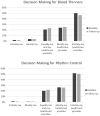Shared decision-making in atrial fibrillation: patient-reported involvement in treatment decisions
- PMID: 32392287
- PMCID: PMC7778449
- DOI: 10.1093/ehjqcco/qcaa040
Shared decision-making in atrial fibrillation: patient-reported involvement in treatment decisions
Abstract
Aims: To determine the extent of shared decision-making (SDM), during selection of oral anticoagulant (OAC) and rhythm control treatments, in patients with newly diagnosed atrial fibrillation (AF).
Methods and results: We evaluated survey data from 1006 patients with new-onset AF enrolled at 56 US sites participating in the SATELLITE substudy of the Outcomes Registry for Better Informed Treatment of Atrial Fibrillation (ORBIT II). Patients completed surveys at enrolment and at 6-month follow-up. Patients were asked about who made their AF treatment decisions. Shared decision-making was classified as one that the patient felt was an autonomous decision or a shared decision with their healthcare provider (HCP). Approximately half of patients reported that their OAC treatment decisions were made entirely by their HCP. Compared with those reporting no SDM, patients reporting SDM for OAC were more often female (47.2% vs. 38.4%), while patients reporting SDM for rhythm control were more often male (62.2% vs. 57.6%). The most important factors cited by patients during decision-making for OAC were reducing stroke and bleeding risk, and their HCP's recommendations. After adjustment, patients with self-reported understanding of OAC, and rhythm control options, had higher odds of having participated in SDM [odds ratio (OR) 2.54, confidence interval (CI): 1.75-3.68 and OR 2.36, CI: 1.50-3.71, both P ≤ 0.001, respectively].
Conclusion: Shared decision-making is not widely implemented in contemporary AF practice. Patient understanding about available therapeutic options is associated with a more than a two-fold higher likelihood of SDM, and may be a potential target for future interventions.
Keywords: Atrial Fibrillation; Patient-reported involvement in treatment decisions; Quality of care; Shared decision-making; Stroke prevention.
Published on behalf of the European Society of Cardiology. All rights reserved. © The Author(s) 2020. For permissions, please email: journals.permissions@oup.com.
Figures
Comment in
-
Shared decision-making: the patient on the forefront of care coordination.Eur Heart J Qual Care Clin Outcomes. 2020 Oct 1;6(4):231-233. doi: 10.1093/ehjqcco/qcaa039. Eur Heart J Qual Care Clin Outcomes. 2020. PMID: 32592469 No abstract available.
Similar articles
-
Assessment of Shared Decision-making for Stroke Prevention in Patients With Atrial Fibrillation: A Randomized Clinical Trial.JAMA Intern Med. 2020 Sep 1;180(9):1215-1224. doi: 10.1001/jamainternmed.2020.2908. JAMA Intern Med. 2020. PMID: 32897386 Free PMC article. Clinical Trial.
-
Development of a shared decision-making tool to assist patients and clinicians with decisions on oral anticoagulant treatment for atrial fibrillation.Curr Med Res Opin. 2015 Dec;31(12):2261-72. doi: 10.1185/03007995.2015.1096767. Epub 2015 Oct 22. Curr Med Res Opin. 2015. PMID: 26390360
-
Impact of shared decision-making in Taiwanese patients with atrial fibrillation eligible for novel oral anticoagulant therapy.J Formos Med Assoc. 2025 Mar;124(3):227-233. doi: 10.1016/j.jfma.2024.08.036. Epub 2024 Sep 7. J Formos Med Assoc. 2025. PMID: 39245609
-
Decision aids for shared decision-making and appropriate anticoagulation therapy in patients with atrial fibrillation: a systematic review and meta-analysis.Eur J Cardiovasc Nurs. 2022 Mar 3;21(2):97-106. doi: 10.1093/eurjcn/zvab085. Eur J Cardiovasc Nurs. 2022. PMID: 34550376
-
Shared Decision Making Tools for People Facing Stroke Prevention Strategies in Atrial Fibrillation: A Systematic Review and Environmental Scan.Med Decis Making. 2021 Jul;41(5):540-549. doi: 10.1177/0272989X211005655. Epub 2021 Apr 24. Med Decis Making. 2021. PMID: 33896270 Free PMC article.
Cited by
-
Oral anticoagulation use in non-valvular atrial fibrillation patients in rural setting.Am J Med Open. 2022 Oct 13;9:100026. doi: 10.1016/j.ajmo.2022.100026. eCollection 2023 Jun. Am J Med Open. 2022. PMID: 39035056 Free PMC article.
-
Assessment and mitigation of bleeding risk in atrial fibrillation and venous thromboembolism: A Position Paper from the ESC Working Group on Thrombosis, in collaboration with the European Heart Rhythm Association, the Association for Acute CardioVascular Care and the Asia-Pacific Heart Rhythm Society.Europace. 2022 Nov 22;24(11):1844-1871. doi: 10.1093/europace/euac020. Europace. 2022. PMID: 35323922 Free PMC article.
-
Patients' experiences of atrial fibrillation and comorbidity management in clinical practice: a pan-European qualitative descriptive interview study.BMJ Open. 2025 Jun 16;15(6):e094839. doi: 10.1136/bmjopen-2024-094839. BMJ Open. 2025. PMID: 40523789 Free PMC article.
-
Impact of the COVID-19 Pandemic on Providing Recommendations During Goals-of-Care Conversations: A Multisite Survey.J Palliat Med. 2023 Jul;26(7):951-959. doi: 10.1089/jpm.2022.0394. Epub 2023 Mar 21. J Palliat Med. 2023. PMID: 36944150 Free PMC article.
-
Assessment of Days Alive Out of Hospital as a Possible End Point in Trials of Stroke Prevention for Atrial Fibrillation: A ROCKET AF Analysis.J Am Heart Assoc. 2024 Jun 4;13(11):e028951. doi: 10.1161/JAHA.122.028951. Epub 2024 May 23. J Am Heart Assoc. 2024. PMID: 38780169 Free PMC article. Clinical Trial.
References
-
- Go AS, Hylek EM, Phillips KA, Chang Y, Henault LE, Selby JV et al. Prevalence of diagnosed atrial fibrillation in adults. JAMA 2001;285:2370. - PubMed
-
- Plitt A, McGuire DK, Giugliano RP. Atrial fibrillation, type 2 diabetes, and non–vitamin K antagonist oral anticoagulants. JAMA Cardiol 2017;2:442. - PubMed
-
- Ogawa S, Yamashita T, Yamazaki T, Aizawa Y, Atarashi H, Inoue H et al. Optimal treatment strategy for patients with paroxysmal atrial fibrillation. Circ J 2009;73:242–248. - PubMed


